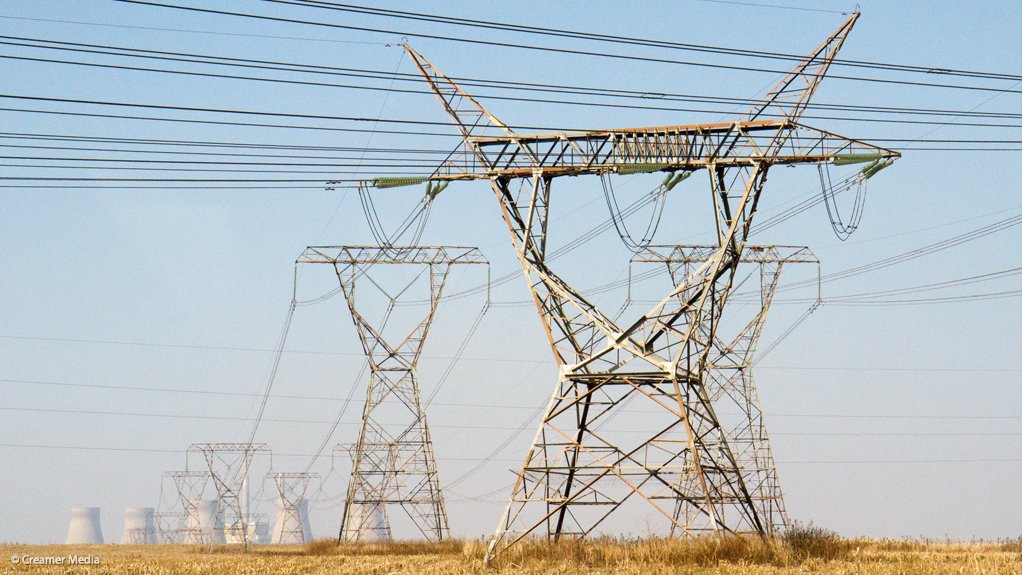State-owned electricity utility Eskom has sounded a warning that, even if its allowable revenue is not increased at all for the 2018/19 year, tariffs will still need to rise by 9.4% simply to accommodate a “rebasing” of electricity sales volumes when compared with those approved in the third multiyear price determination period (MYPD3).
The utility has made a single-year application to the National Energy Regulator of South Africa (Nersa) for allowable revenue of R219.5-billion, which would translate to a hike of 19.9% from April 1 for direct customers and 27.5% for municipalities from July 1.
The submission, which is available on Nersa’s website, includes a request for R13.2-billion in higher operating expenses, R11.2-billion in additional independent power producer (IPP) costs, a R1-billion increase in primary-energy costs and R2.8-billion for international purchases. Even after “sacrificing” R12-billion in its return-on-assets request, based on a decision to “phase-in” its weighted average cost of capital over time, and factoring a R1.8-billion reduction in the environmental levy, owing to a fall in the amount of energy sent out, its submission still translates to what would be a significantly above-inflation hike from April 1.
However, GM for regulation Hasha Tlhotlhalemaje explains that, over the entire MYPD3 period, Eskom’s sales volumes have been significantly lower than those assumed in that five-year determination, which expires on March 31. For this reason, rebasing for lower sales is a large part of the overall increase being applied for.
By 2016/17, the MYPD3 had assumed sales of 239 133 GWh, whereas, in reality, the utility sold only 214 121 GWh. Standard tariff sales volumes alone – which exclude Eskom’s negotiated pricing agreements and export tariffs – were 30 TWh lower, at 193 TWh in 2016/17, than the 223 TWh assumed in the MYPD3.
Tlhotlhalemaje says that, over the MYPD3 period, volumes were not adjusted to reflect the weaker sales performance, partly owing to a legal challenge to Nersa’s adjudication of the utility’s Regulatory Clearing Account (RCA) submissions. Therefore, the volume adjustment to reflect the actual sales will occur during the revenue application for 2018/19.
“So, even if the allowed revenue is not increased, the recovery through lower sales volumes will result in a price increase,” she explains, while calculating the net impact of such rebasing to be a 9.4% increase.
Corporate specialist for finance and regulation Deon Joubert argues that it is important to correct the sales volumes, as embedded in the sales is the recovering of Eskom’s fixed costs. “Eskom is not receiving the full allowed operating costs, depreciation and returns when volumes are lower than the assumption in the Nersa decision,” he explains.
Meanwhile, senior manager for electricity pricing Deon Conradie stresses that the utility is pursuing a four-pronged demand stimulation strategy to recover sales, which, if effective, will reverse the trend of over-estimating volumes.
The initial focus will be on sustaining demand from customers in distress through short-term support packages, while also expediting new projects. In the medium-term, it would be actively seeking out new customers and deploying new products and solutions to stimulate demand.
The utility claims to have up to 4 000 MW of surplus available on a daily basis and has indicated that this excess-supply situation could persist until at least 2021. It is, therefore, aiming to recover sales volumes and has set a target of growing yearly domestic sales by 2.1% over the coming fives years, while increasing export sales by 8% a year over the same period.
Eskom will make its case for the double-digit increase at a series of Nersa public hearings to be held in all nine provinces between October 30 and November 16, with the first hearing scheduled for Cape Town and the last for Johannesburg.
The utility does not expect any movement on the adjudication of its three outstanding RCA applications while Nersa deliberates on the 2018/19 revenue application. However, it will continue to pursue R60-billion in foregone revenue for years two, three and four of the MYPD3 at a later stage, especially now that certainty has been established on the legality of the mechanism and Nersa application thereof.
Already the pushback has been firm, with Business Unity South Africa warning that the electricity utility may be approaching a sustainability “tipping point”, while the Energy Intensive Users Group of Southern Africa is warning that the tariff is approaching a price point where it could trigger partial or total grid defection. AfriBusiness has indicated that it plans to oppose a further hike, while the Nelson Mandela Bay Business Chamber warns that another large tariff increase hike would be “crippling” to business and the economy.
Likewise, the Congress of South African Trade Unions has raised concern about the prospect of another growth-sapping hike in the context of which its sees as “corruption and chaos” at the utility.
Corporate specialist in Eskom’s Treasury, Mandla Maleka, acknowledges that a 19.9% hike will have a negative impact on gross domestic product (GDP) and employment growth relative to the MYPD3 baseline scenario of 8% a year.
However, he warns that under an 8% tariff baseline scenario, there would be a steady and marked deterioration in government’s Budget balance and that the debt-to-GDP ratio could rise to 75% by 2021. “By contrast, under the 19% tariff scenario, the debt-to-GDP ratio stabilises at around 66%.”
In 2017/18, Eskom's average tariff is 85c/kWh (or about US6.5c/kWh) for generation, transmission and distribution and the upcoming Nersa deliberations will be key to determining the future price point for direct customers.
EMAIL THIS ARTICLE SAVE THIS ARTICLE ARTICLE ENQUIRY
To subscribe email subscriptions@creamermedia.co.za or click here
To advertise email advertising@creamermedia.co.za or click here











